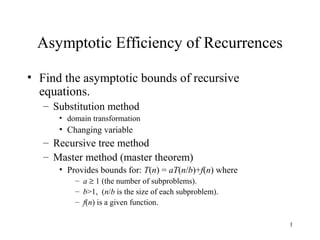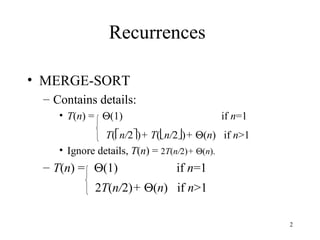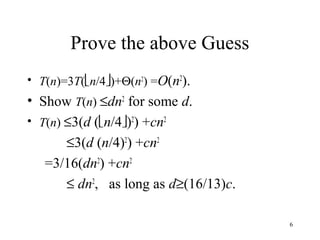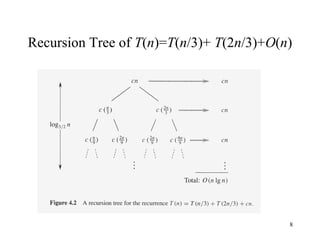Recurrence theorem
- 1. 1 Asymptotic Efficiency of Recurrences • Find the asymptotic bounds of recursive equations. – Substitution method • domain transformation • Changing variable – Recursive tree method – Master method (master theorem) • Provides bounds for: T(n) = aT(n/b)+f(n) where – a ≥ 1 (the number of subproblems). – b>1, (n/b is the size of each subproblem). – f(n) is a given function.
- 2. 2 Recurrences • MERGE-SORT – Contains details: • T(n) = Θ(1) if n=1 T(n/2)+ T(n/2)+ Θ(n) if n>1 • Ignore details, T(n) = 2T(n/2)+ Θ(n). – T(n) = Θ(1) if n=1 2T(n/2)+ Θ(n) if n>1
- 3. 3 The Recursion-tree Method • Idea: – Each node represents the cost of a single subproblem. – Sum up the costs with each level to get level cost. – Sum up all the level costs to get total cost. • Particularly suitable for divide-and-conquer recurrence. • Best used to generate a good guess, tolerating “sloppiness”. • If trying carefully to draw the recursion-tree and compute cost, then used as direct proof.
- 4. 4 Recursion Tree for T(n)=3T(n/4)+Θ(n2 ) T(n) (a) cn2 T(n/4) T(n/4) T(n/4) (b) cn2 c(n/4)2 c(n/4)2 c(n/4)2 T(n/16) T(n/16) T(n/16)T(n/16)T(n/16)T(n/16 ) T(n/16) T(n/16) T(n/16) (c) cn2 c(n/4)2 c(n/4)2 c(n/4)2 c(n/16)2 c(n/16)2 c(n/16)2 c(n/16)2 c(n/16)2 c(n/16)2 c(n/16)2 c(n/16)2 c(n/16)2 cn2 (3/16)cn2 (3/16)2 cn2 T(1)T(1) T(1)T(1) T(1)T(1) Θ(nlog 4 3 ) 3log4n = nlog 4 3 Total O(n2 ) log 4 n (d)
- 5. 5 Solution to T(n)=3T(n/4)+Θ(n2 ) • The height is log 4 n, • #leaf nodes = 3log4 n = nlog4 3 . Leaf node cost: T(1). • Total cost T(n)=cn2 +(3/16) cn2 +(3/16)2 cn2 + ⋅⋅⋅ +(3/16)log4 n-1 cn2 + Θ(nlog4 3 ) =(1+3/16+(3/16)2 + ⋅⋅⋅ +(3/16)log4 n-1 ) cn2 + Θ(nlog4 3 ) <(1+3/16+(3/16)2 + ⋅⋅⋅ +(3/16)m + ⋅⋅⋅) cn2 + Θ(nlog4 3 ) =(1/(1-3/16)) cn2 + Θ(nlog4 3 ) =16/13cn2 + Θ(nlog4 3 ) =O(n2 ).
- 6. 6 Prove the above Guess • T(n)=3T(n/4)+Θ(n2 ) =O(n2 ). • Show T(n) ≤dn2 for some d. • T(n) ≤3(d (n/4)2 ) +cn2 ≤3(d (n/4)2 ) +cn2 =3/16(dn2 ) +cn2 ≤ dn2 , as long as d≥(16/13)c.
- 7. 7 One more example • T(n)=T(n/3)+ T(2n/3)+O(n). • Construct its recursive tree ( Figure 4.2, page 71). • T(n)=O(cnlg3/2 n) = O(nlg n). • Prove T(n) ≤ dnlg n.
- 8. 8 Recursion Tree of T(n)=T(n/3)+ T(2n/3)+O(n)







